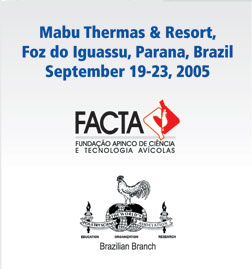Efficacy of gel spray as a delivery system for turkey
coccidiosis vaccine consisting of Eimeria adenoeides
and E. meleagrimites
Eng H. Lee1 and R. Soares
Vetech Laboratories Inc., 131 Malcolm
Road,
Guelph, Ontario, Canada, N1K 1A8
The first coccidiosis vaccine
launched in the market, based on the theory of uniform
exposure (Lee, 1986; Shirley & Long, 1990), was
a carrageenan-based vaccine, which objective is to
increase water viscosity and to maintain an even suspension
of oocysts. This procedure was later adopted to produce
a commercial product in the form of edible gel placed
in the chick tray (Dasgupta & Lee, 2000). The
idea of uniformity was also tested in the spray cabinet
(Danforth, 1997) as water spray. This became popular
because of its convenience. However, oocyst distribution
before and after vaccination remains an issue. There
is no problem in uniformity during stirring before
spraying, but uniformity after spraying and before
ingestion may be questionable. Here we report a gel
spray delivery system using a gel diluent that may
solve this problem.
Experiment 1: A turkey coccidiosis vaccine, containing
Eimeria meleagrimitis and E. adenoeides, was administered
to poults by one of three routes: gel spray, edible
gel, or drinking water. Positive- and negative- control
groups were included in the study. Poults were challenged
with a high dose of turkey coccidia on day 15. Edible
gel vaccine delivery provided the best protection
, as measured byweight gain, against the challenge
with turkey coccidia as compared to drinkingwater
or spray delivery.. However, all three delivery routes
significantly (p<0.03) prevented weight reduction
as compared to non-vaccinated and challenged controls.
When efficacy was measured as lesion score, vaccine
delivered by gel spray or in drinking water produced
better results than edible gel. We concluded that
gel spray is a more efficient anti-coccidial vaccine
delivery route, as measured by weight gain and lesion
score, then drinking water or edible gel..
Experiment 2: Poults, which were vaccinated with the
two Eimeria species vaccine and were challenged, gained
more weight than non-vaccinated and challenged poults
This weight gain was statistically significant (p<0.0093
for E. ad challenge, and p=0.0380 for E.me challenge
). Vaccinated and challenged poults had statistically
significant lower (p<0.001) lesion scores as compared
to non-vaccinated and challenged poults . We again
concluded that poult vaccination by gel spray prevents
weight gain reduction and also decreases morbidity
as compared to unprotected and challenged controls.
1To whom
correspondence should be addressed: elee@vetechinc.com
